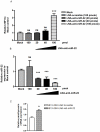MicroRNA-22 can reduce parathymosin expression in transdifferentiated hepatocytes
- PMID: 22493679
- PMCID: PMC3320904
- DOI: 10.1371/journal.pone.0034116
MicroRNA-22 can reduce parathymosin expression in transdifferentiated hepatocytes
Abstract
Pancreatic acinar cells AR42J-B13 can transdifferentiate into hepatocyte-like cells permissive for efficient hepatitis B virus (HBV) replication. Here, we profiled miRNAs differentially expressed in AR42J-B13 cells before and after transdifferentiation to hepatocytes, using chip-based microarray. Significant increase of miRNA expression, including miR-21, miR-22, and miR-122a, was confirmed by stem-loop real-time PCR and Northern blot analyses. In contrast, miR-93, miR-130b, and a number of other miRNAs, were significantly reduced after transdifferentiation. To investigate the potential significance of miR-22 in hepatocytes, we generated cell lines stably expressing miR-22. By 2D-DIGE, LC-MS/MS, and Western blot analyses, we identified several potential target genes of miR-22, including parathymosin. In transdifferentiated hepatocytes, miR-22 can inhibit both mRNA and protein expression of parathymosin, probably through a direct and an indirect mechanism. We tested two computer predicted miR-22 target sites at the 3' UTR of parathymosin, by the 3' UTR reporter gene assay. Treatment with anti-miR-22 resulted in significant elevation of the reporter activity. In addition, we observed an in vivo inverse correlation between miR-22 and parathymosin mRNA in their tissue distribution in a rat model. The phenomenon that miR-22 can reduce parathymosin protein was also observed in human hepatoma cell lines Huh7 and HepG2. So far, we detected no major effect on several transdifferentiation markers when AR42J-B13 cells were transfected with miR-22, or anti-miR-22, or a parathymosin expression vector, with or without dexamethasone treatment. Therefore, miR-22 appears to be neither necessary nor sufficient for transdifferentiation. We discussed the possibility that altered expression of some other microRNAs could induce cell cycle arrest leading to transdifferentiation.
Conflict of interest statement
Figures











Similar articles
-
Hepatocyte-like cells transdifferentiated from a pancreatic origin can support replication of hepatitis B virus.J Virol. 2005 Oct;79(20):13116-28. doi: 10.1128/JVI.79.20.13116-13128.2005. J Virol. 2005. PMID: 16189013 Free PMC article.
-
Characterization of liver function in transdifferentiated hepatocytes.J Cell Physiol. 2006 Jan;206(1):147-59. doi: 10.1002/jcp.20438. J Cell Physiol. 2006. PMID: 15965953
-
A putative role of micro RNA in regulation of cholesterol 7alpha-hydroxylase expression in human hepatocytes.J Lipid Res. 2010 Aug;51(8):2223-33. doi: 10.1194/jlr.M004531. Epub 2010 Mar 29. J Lipid Res. 2010. PMID: 20351063 Free PMC article.
-
Enhanced expression of hepatocyte-specific microRNAs in valproic acid mediated hepatic trans-differentiation of human umbilical cord derived mesenchymal stem cells.Exp Cell Res. 2016 May 1;343(2):237-247. doi: 10.1016/j.yexcr.2016.03.015. Epub 2016 Mar 18. Exp Cell Res. 2016. PMID: 27001466
-
Diosbulbin B induced G2/M cell cycle arrest in hepatocytes by miRNA-186-3p and miRNA-378a-5p-mediated the decreased expression of CDK1.Toxicol Appl Pharmacol. 2018 Oct 15;357:1-9. doi: 10.1016/j.taap.2018.08.016. Epub 2018 Aug 23. Toxicol Appl Pharmacol. 2018. PMID: 30145177
Cited by
-
Nuclear export of human hepatitis B virus core protein and pregenomic RNA depends on the cellular NXF1-p15 machinery.PLoS One. 2014 Oct 31;9(10):e106683. doi: 10.1371/journal.pone.0106683. eCollection 2014. PLoS One. 2014. PMID: 25360769 Free PMC article.
-
Spatiotemporal control of microRNA function using light-activated antagomirs.Mol Biosyst. 2012 Nov;8(11):2987-93. doi: 10.1039/c2mb25175b. Mol Biosyst. 2012. PMID: 22945263 Free PMC article.
-
MicroRNA miR-204 and miR-1236 inhibit hepatitis B virus replication via two different mechanisms.Sci Rep. 2016 Oct 13;6:34740. doi: 10.1038/srep34740. Sci Rep. 2016. PMID: 27734898 Free PMC article.
-
MicroRNA-130a can inhibit hepatitis B virus replication via targeting PGC1α and PPARγ.RNA. 2015 Mar;21(3):385-400. doi: 10.1261/rna.048744.114. Epub 2015 Jan 16. RNA. 2015. PMID: 25595716 Free PMC article.
References
-
- Rao MS, Dwivedi RS, Subbarao V, Usman MI, Scarpelli DG, et al. Almost total conversion of pancreas to liver in the adult rat: a reliable model to study transdifferentiation. Biochem Biophys Res Commun. 1988;156:131–136. - PubMed
-
- Tosh D, Shen CN, Alison MR, Sarraf CE, Slack JM. Copper deprivation in rats induces islet hyperplasia and hepatic metaplasia in the pancreas. Biol Cell. 2007;99:37–44. - PubMed
-
- Shen CN, Slack JM, Tosh D. Molecular basis of transdifferentiation of pancreas to liver. Nat Cell Biol. 2000;2:879–887. - PubMed
Publication types
MeSH terms
Substances
LinkOut - more resources
Full Text Sources
Other Literature Sources

